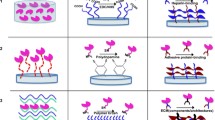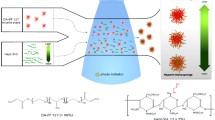Abstract
One of the advances in biotechnology has been the development of the capability to produce large quantities of highly purified polypeptides and proteins. Unfortunately, the circulatory half-lives of many of these agents are short, usually of the order of minutes and the time required for a response in tissues is usually long compared to the half-life. Hence, there is always demand for polymeric systems which can deliver the proteins for prolonged period and also to protect the molecules from degradation. The present work was attempted to develop heparin-functionalized gelatin microspheres (HMS) to deliver heparin-binding growth factors particularly for wound-healing applications. The heparin conjugation was carried out using EDC/NHS coupling protocol. Heparin-binding EGF-like growth factor (HB-EGF) was loaded in HMS and its in vitro release behaviour in an environment with or without proteases was studied. The bioactivity of the HB-EGF released from the microspheres was assessed using NIH 3T3 mouse embryonic fibroblast culture. The extent of heparin modification was found to be 1.97 μmol/g of HMS and demonstrated significant protection against enzymatic degradation and sustained release of HB-EGF for more than 10 days. The bioactivity of HB-EGF released from the HMS was retained during the observed release period. The HMS was also found to be non-toxic as determined by calcein AM fluorescent staining. The overall study suggests that the HMS could be used as a growth factor’s delivery component in tissue engineering scaffolds particularly for wound-healing applications.








Similar content being viewed by others
References
Choi JS, Leong KW, Yoo HS (2008) In vivo wound healing of diabetic ulcers using electrospun nanofibers immobilized with human epidermal growth factor (EGF). Biomaterials 29:587–596
Cooper DM, Yu EZ, Hennessey P, Ko F, Robson MC (1994) Cryopreserved saphenous vein allografts for below-knee lower extremity revascularization. Ann Surg 219:688–692
Yager DR, Zhang LY, Liang HX, Diegelmann RF, Cohen IK (1996) Wound fluids from human pressure ulcers contain elevated matrix metalloproteinase levels and activity compared to surgical wound fluids. J Investig Dermatol 107:743–748
Falanga V, Eaglstein WH (1993) The “trap” hypothesis of venous ulceration. Lancet 341:1006–1008
Higley HR, Ksander GA, Gerhardt CO, Falanga V (1995) Extravasation of macromolecules and possible trapping of transforming growth factor-β in venous ulceration. Br J Dermatol 132:79–85
Robson MC, Mustoe TA, Hunt TK (1998) The future of recombinant growth factors in wound healing. Am J Surg 176:80S–82S
Bennett SP, Griffiths GD, Schor AM, Leese GP, Schor SL (2003) Growth factors in the treatment of diabetic foot ulcers. Br J Surg 90:133–146
Smiell JM, Wieman TJ, Steed DL, Perry BH, Sambson AR, Schwab BH (1999) Efficacy and safety of becaplermin (recombinant human platelet-derived growth factor-BB) in patients with nonhealing, lower extremity diabetic ulcers: a combined analysis of four randomized studies. Wound Repair Regen 7:335–346
Andreopoulos FM, Persaud I (2006) Delivery of basic fibroblast growth factor (bFGF) from photoresponsive hydrogel scaffolds. Biomaterials 27:2468–2476
Zhu XH, Tabata Y, Wang HH, Tong Y (2008) Delivery of basic fibroblast growth factor from gelatin microsphere scaffold for the growth of human umbilical vein endothelial cells. Tissue Eng Part A 14:1939–1947
Gospodarowicz D, Cheng J (1986) Heparin protects basic and acidic FGF from inactivation. J Cell Physiol 128:475–484
Wissink MJB, Beernink R, Pieper JS, Poot AA, Engbers GHM, Beugeling T, Van Aken WG, Feijen J (2001) Binding and release of basic fibroblast growth factor from heparinized collagen matrices. Biomaterials 22:2291–2299
Tanihara M, Suzuki Y, Yamamoto E, Noguchi A, Mizushima Y (2001) Sustained release of basic fibroblast growth factor and angiogenesis in a novel covalently crosslinked gel of heparin and alginate. J Biomed Mater Res 56:216–221
Chung Y, Tae G, Yuk SH (2006) A facile method to prepare heparin-functionalized nanoparticles for controlled release of growth factors. Biomaterials 27:2621–2626
Lee JS, Go DH, Bae JW, Lee SJ, Park KD (2007) Heparin conjugated polymeric micelle for long-term delivery of basic fibroblast growth factor. J Control Release 117:204–209
Tabata Y, Hijikata S, Ikada Y (1994) A novel skeletal drug delivery system using self-setting bioactive glass bone cement. III: the in vitro drug release from bone cement containing indomethacin and its physicochemical properties. J Control Release 31:111–119
Morimoto K, Chono S, Kosai T (2008) Design of cationic microspheres based on aminated gelatin for controlled release of peptide and protein drugs. Drug Deliv 15:113–117
Kosasih A, Bowman BJ, Wigent RJ, Ofner CM (2000) Characterization and in vitro release of methotrexate from gelatin/methotrexate conjugates formed using different preparation variables. Int J Pharm 204:81–89
Wang J, Tabata Y, Morimoto K (2006) Aminated gelatin microspheres as a nasal delivery system for peptide drugs: evaluation of in vitro release and in vivo insulin absorption in rats. J Control Release 113:31–37
Tabata Y, Ikada Y (1998) Protein release from gelatin matrices. Adv Drug Deliv Rev 31:287–301
Adhirajan N, Shanmugasundaram N, Shanmuganathan S, Babu M (2009) Functionally modified gelatin microspheres impregnated collagen scaffold as novel wound dressing to attenuate the proteases and bacterial growth. Eur JPharm Sci 36:235–245
Radulescu A, Zhang H, Chen CL, Chen Y, Zhou Y, Yu X, Otabor L, Olson JK, Besner GE (2011) Heparin-binding EGF-like growth factor promotes intestinal anastomotic healing. J Surg Res 171:540–550
Adhirajan N, Shanmugasundaram N, Babu M (2007) Gelatin microspheres cross-linked with EDC as a drug delivery system for doxycycline: development and characterization. J Microencapsul 24:659–671
Smith PK, Mallia S, Hermanson GT (1980) Colorimetric method for the assay of heparin content in immobilized heparin preparations. Anal Biochem 109:466–473
Olde D, Dijkstra PJ, Van Luyn VKA, Van Wachem PB, Nieuwenhuis P, Feijen J (1996) Cross-linking of dermal sheep collagen using a water-soluble carbodiimide. Biomaterials 17:765–773
Kuijpers AJ, Engbers GHM, Krijgsveld J, Zaat SAJ, Dankert J, Feijen J (2000) Cross-linking and characterisation of gelatin matrices for biomedical applications. J Biomater Sci Polym Ed 11:225–243
van Kuppervelt TM, Veerkamp JH (1994) Application of cationic probes for the ultrastructural localization of proteoglycans in basement membranes. Microsc Res Techn 28:125–140
Nimni ME, Harkness RD (1988) Molecular structure and function of collagen. In: Nimni ME (ed) Collagen, vol I. CRC Press, Boca Raton, pp 1–77
Yao C, Roderfeld M, Rath T, Roeb E, Bernhagen J, Steffens G (2006) The impact of proteinase-induced matrix degradation on the release of VEGF from heparinized collagen matrices. Biomaterials 27:1608–1616
Dogan AK, Gumusderelioglu M, Aksoz E (2005) Controlled release of EGF and bFGF from dextran hydrogels in vitro and in vivo. J Biomed Mater Res B Appl Biomater 74:504–510
Kanematsu A, Yamamoto S, Ozeki M, Noguchi T, Kanatani I, Ogawa O, Tabata Y (2004) Collagenous matrices as release carriers of exogenous growth factors. Biomaterials 25:4513–4520
Raab G, Klagsbrun M (1997) Heparin-binding EGF-like growth factor. Biochim Biophys Acta 1333:F179–F185
Berner G, Higashiyama S, Klagsbrun M (1990) Isolation and characterization of a macrophage-derived heparin-binding growth factor. Cell Regul 1:811–819
Acknowledgments
This work was supported by Department of Biotechnology, Ministry of Science and Technology, New Delhi, India (Grant No. BT/PR8203/MED/14/1237/2006). The authors thank the Director, CLRI, for giving us the opportunity and encouragement to carry out this work.
Author information
Authors and Affiliations
Corresponding author
Rights and permissions
About this article
Cite this article
Adhirajan, N., Thanavel, R., Naveen, N. et al. Functionally modified gelatin microspheres as a growth factor’s delivery system: development and characterization. Polym. Bull. 71, 1015–1030 (2014). https://doi.org/10.1007/s00289-014-1108-3
Received:
Revised:
Accepted:
Published:
Issue Date:
DOI: https://doi.org/10.1007/s00289-014-1108-3




